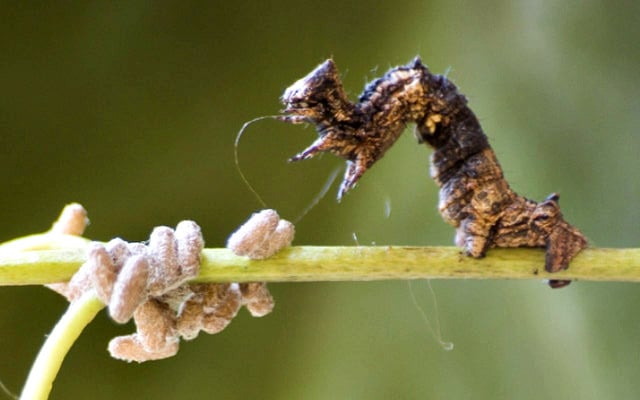Thyrinteina leucocerae, the caterpillar of the geometer moth, is targeted as a host for a species of parasitoid wasp that can lay up to 80 eggs inside its body. The caterpillar’s reward is a job as bodyguard for the very parasites growing inside it and a slow, agonizing death.
The Glyptapanteles wasp is one of nature’s most fascinating and, at the same time, terrifying body-snatchers. Not only does its lay dozens of eggs into caterpillar hosts, but scientists claim that the insect can somehow change the behavior of the host, turning into a mindless bodyguard whose only mission is to protect the wasp’s eggs against predators. Once the wasp grubs hatch out of its body and begin to spin their pupae, the caterpillar stops moving, stops eating, gets on its hind legs and goes into statue mode. But at the slightest threat for the wasp “babies”, it starts swinging its head violently to drive predators away.

Photo: José Lino-Neto
Researchers had long observed the unusual behavior of the caterpillar, but it was Amir Grosman, from the University of Amsterdam, who found that it was all part of the manipulation of the wasp. In a 2008 study conducted with the help of Dutch and Brazilian scientists, Grosman showed that infected Thyrinteina leucocerae caterpillars were just as active as unaffected ones. However, as the wasp eggs hatched, the vast majority of infected hosts changed their behavior, turning into bodyguards for their own killers.
The zombie guardians didn’t move, didn’t eat, they only bobbed their heads violently whenever stinkbugs approached. Interestingly, all infected Thyrinteina leucocerae reacted this way in the presence of stinkbugs, but only one in 20 unaffected caterpillars displayed similar behavior.
Grosman’s study showed that the Thyrinteina leucocerae caterpillars’ head-bobbing defense was an effective one, as in about 60% of cases, stinkbugs either gave up trying to eat the wasp pupae, or were knocked off their branches. When the mindless bodyguards were removed, the death rate of wasp pupae doubled. Unfortunately, the caterpillars’ only reward for their work is a slow death. In the 2008 study, all of the infected Thyrinteina leucocerae died within a week after the wasp pupae opened.
Science hasn’t yet been able to explain, without any shadow of doubt, how the Glyptapanteles wasp manipulates its hosts. Grosman and his team concluded that the wasp pupae don’t secrete any mind-altering chemicals, because putting them next to unaffected hosts doesn’t have any infect on them. The planting of the eggs inside the caterpillar doesn’t seem to be the trigger either, as changes only appear two weeks later, and neither is the hatching of the eggs, as artificially damaged caterpillars don’t behave the same way.
When dissecting infected geometer moth caterpillars, Amir Grosman made an intriguing discovery – all the hosts had a few leftover active wasp larvae inside of them. He believes that it is these left-behind parasites that somehow manipulate the caterpillars into assuming the bodyguard role for their siblings. They essentially sacrifice themselves to increase the survival chances of their species.
For more fascinating examples of real-life body-snatchers, check out the parasitic fly that makes bumblebees dig their own graves, the wasp that turns spiders into zombies, or the fungus that takes control of ants’ muscles while leaving their brain intact. They’ll all make you say “nature, you nasty!”












